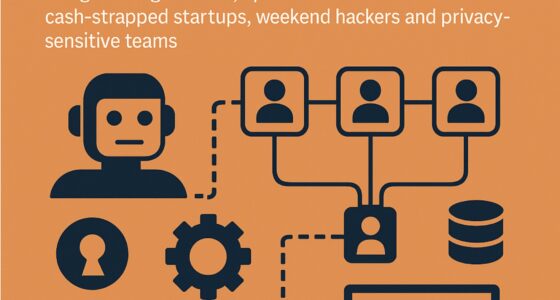In the AI era, transparency is your key to building trust because it reveals how decisions are made and guarantees fairness, accountability, and societal acceptance. When AI systems openly share their processes, you can better identify biases, errors, or misuse. This openness not only boosts confidence but also helps meet legal and ethical standards. Keep exploring, and you’ll discover how standardized transparency practices are shaping responsible AI deployment across industries.
Key Takeaways
- Transparency reveals AI decision processes, fostering trust among users and stakeholders.
- Clear explanations of algorithms and data inputs help identify biases and errors.
- Standardized transparency frameworks ensure consistent and responsible AI deployment.
- Transparent AI systems enable oversight, ensuring ethical and fair operation.
- Increased transparency supports regulatory compliance and promotes social acceptance.

Understanding AI transparency is vital as it guarantees clarity and openness about how AI systems make decisions. When you know what’s happening behind the scenes, trust in the technology grows. Transparency helps demystify the “black box” nature of AI by explaining how models reach their outcomes and the decision processes involved. This is especially important in high-stakes sectors like healthcare, finance, law enforcement, and HR, where decisions can significantly impact people’s lives. By disclosing the logic behind AI, including data inputs and evaluation methods, you can assess whether the system is fair, unbiased, and accurate. This openness aligns AI development with societal values, ethics, and legal standards, guaranteeing responsible use and accountability.
AI transparency builds trust by revealing decision processes, ensuring fairness, and aligning with societal values in critical sectors.
Transparency isn’t just about revealing technical details; it encompasses different levels of disclosure. You might have access to explanations of the algorithm’s design or a full breakdown of data sources and model logic. The goal is to foster social control and guarantee organizations act responsibly, especially when deploying high-risk AI systems. Transparency also involves acknowledging the interests of system providers and their social responsibilities, helping to prevent misuse or unintended harm. It acts as a form of oversight, making sure AI operates ethically and fairly. Additionally, implementing standardized frameworks can facilitate consistent transparency practices across diverse industries and applications.
The benefits of transparency are clear. When you can scrutinize AI systems, trust and confidence increase, encouraging wider acceptance. Transparency allows you to spot biases or errors that could lead to unfair outcomes, supporting fairness and justice. It also helps organizations comply with regulations like the AI Act, protecting privacy and security. By unveiling how AI functions, stakeholders can prevent misuse, disinformation, and threats to democratic processes. Transparency acts like a “nutrition label” for AI, balancing openness with the need to protect proprietary methods and sensitive information. Research shows that establishing standardized frameworks can significantly improve transparency practices across industries.
Frequently Asked Questions
How Can Consumers Verify AI Transparency Claims?
You can verify AI transparency claims by checking if the system complies with regulations like the EU AI Act or the U.S. AI Bill of Rights, which mandate auditability. Look for official reports, transparent data usage, and clear explanations of decision-making processes. Test if the AI provides understandable reasons for outcomes and offers interactive features. Reviewing audit logs, dashboards, or third-party assessments can also help confirm the system’s transparency and accountability.
What Are the Legal Implications of AI Transparency?
Imagine a world where hidden truths threaten your rights—AI transparency laws turn that fear into trust. Legally, failing to disclose AI use or violating safety standards can lead to hefty fines, lawsuits, and reputational damage. You’re protected by regulations requiring companies to reveal AI decision-making processes, conduct audits, and report safety issues. Non-compliance risks not only legal penalties but also erodes consumer trust, making transparency a crucial legal safeguard.
How Do Different Industries Implement AI Transparency?
You see industries implementing AI transparency differently based on their needs. Financial services use explainable AI and regular audits to guarantee fairness and build trust. E-commerce clearly discloses AI use and justifies recommendations to users. Tech companies publish detailed safety reports and employ user-friendly explainability tools. Healthcare prioritizes bias reduction, privacy, and clear treatment explanations, while HR focuses on fair hiring practices. These strategies foster trust, compliance, and better user engagement across sectors.
What Role Do Governments Play in AI Transparency Standards?
Governments act like overzealous referees in an AI game, blowing whistles at every questionable move. They set transparency standards, draft regulations, and enforce compliance, aiming to keep AI developers honest. From federal guidelines to state laws and international standards, they shape the playing field. Their role is to guarantee AI systems are safe, fair, and transparent, so you can trust the algorithms don’t have a hidden agenda—like secretly replacing your coffee machine.
Can AI Transparency Influence User Privacy Rights?
AI transparency can considerably influence your privacy rights by ensuring you’re fully informed about how your data is collected, used, and shared. When AI systems are transparent, you gain clearer control over your personal information, including the ability to opt in or out of data practices. This openness helps you challenge or remediate harmful decisions and protects you from unauthorized data use, strengthening your overall privacy rights.
Conclusion
In the AI era, transparency isn’t just a feature—it’s your greatest trust signal. While algorithms grow more complex, your openness keeps relationships clear and genuine. You can’t hide behind layers of code; instead, embracing transparency builds confidence and loyalty. As technology advances, remember: honesty isn’t just good practice—it’s your most powerful asset. In a world of uncertainty, transparency shines as the steady beacon guiding users safely through the digital landscape.









